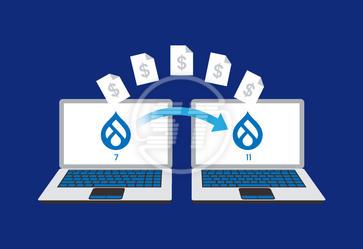There has been a sea of trends in web development with various transformative happenings from a static website to monolithic & dynamic websites. With the ever-evolving technologies, increased customer interactions, and a multitude of touchpoints from progressive web apps to IoT devices, businesses are pulling out all the stops to rapidly innovate and bolster their business strategy. One of the striking marketing innovations adopted by businesses in recent times is a decoupled or headless framework to meet the ever-increasing demands of customers and deliver a rich user experience.
While the headless Drupal CMS space is exploding, after working with various CMS, Drupal CMS seems to be the more mature, fully ready headless CMS and has shown a significant impact on the user experience. It is stable and solid with a clear roadmap of development powering millions of websites. It is also well-supported and backed by a large community of developers providing enterprise-level solutions to the businesses. Before we understand why Headless Drupal is the holy grail and how it is reshaping the business strategies and customer experience, let’s understand what is a headless framework.
What is Headless Drupal or Decoupled Drupal?
In the traditional framework, Drupal offers the end-to-end solution for the users. It is used to create, save, and display the content to the end-user. However, in a headless Drupal, creating and storing are done on Drupal but the display part is decoupled. In Headless Drupal, Drupal serves as the backend content repository while the frontend is built on various technologies and the communication takes place with Drupal via an API. In simple terms, in Headless Drupal the front-end is separated from the backend.
As the content and user experience layer is separated from the business functionality of the backend, the biggest benefit is that you can focus on improving specific key areas without stressing about the impact of it on the other. The front-end is accountable for the presentation aspects and this is detached from the backend aspect which stores and assesses the content. This way you detach the head of the Drupal and the developer can still leverage any JavaScript framework such as React or Angular to render the front-end experience and deliver the quality user experience. The front-end is totally responsible for rendering and markup for the data provided by Drupal and web services. A developer who wants greater control over the frontend finds this as the best option.
Headless Drupal - The Cornerstone of User Experience
A website visitor doesn’t get involved in direct interaction with Drupal and sees only the pages built using JavaScript frameworks. Today, decoupled Drupal has become the cornerstone of digital experiences. Headless Drupal is full of possibilities and molding the customer experience like never before.
Omnichannel Delivery Capabilities
A traditional Drupal has both front-end that presents the content to the user and a back-end that stores the content. Today, the customers are everywhere and brands need to go beyond the delivery of content on websites and web apps. With headless Drupal, we are decoupling the front-end and delivering the content through an API to any device. When the UI is decoupled from the CMS, the front-end and its native tools would be responsible for displaying the content on each device. Also, in the omnichannel experience, with multiple customer touchpoints in the buying journey, the entire game gets quite complex. So with headless CMS, you can make upgrades by running the changes meant for the front-end without disturbing the backend saving you cost, time, and potential risks involved.
The Faster, The Better
Headless Drupal is faster than traditional Drupal and is also highly responsive ensuring a rich customer experience. Decoupled Drupal is faster because the content display is left to the front-end interface and you don’t have to worry about the backend. The constant urge to creating a great first impression and striking a chord with your customers would be fulfilled easily with headless Drupal. A faster site engages customers better.
Personalized Experience
The scope of personalization is also massive with headless Drupal as the administrative functions are separated from the front-end display channels. So, retailers and brands enjoy greater freedom around the frontend, how to present their products and product information, and more. They are focusing on delivering personalized and tailor-made designs keeping the end-user in mind. This ensures a personalized user experience which is much easier than what the traditional ecommerce templates allow for.
Flexibility in Content Display
With headless Drupal, you would have the freedom to tweak as per your specifications. You would be offered the choice of how to display your content on the frontend with an extra layer of security over traditional Drupal. The JavaScript framework also has gained more traction as the demand for greater flexibility in the front-end increased. By emphasizing the client-side rendering, one can provide a more engaging and dynamic customer experience.
Elegant User Interface
Drupal is a fantastic option for content creation and data storage, written in PHP, a server-side rendering engine. If you need an elegant and interactive UI, we recommend you to go for JavaScript frameworks. One can create excellent interactions that are easy and faster. New libraries like Angular, React, Vue help the developers to create complicated frontend applications with great ease. Even the Progressive Web Apps are built on JS. Hence headless Drupal is a great option if you want to build interactive web applications.
Reduce Technological Dependencies
Many modern websites have to maintain a fresh look so they undergo redesign every few years. Companies need to be more dynamic when changing the front-end technologies without the need to rebuild huge Drupal backends. Once the front-end is separated from the backend, it is much easier to rebuild. The overall cost of the website would also be lower.
Closing Thoughts
The success of any business depends on how well one provides the services to the customers. As Headless Drupal is gaining ground and you can leverage this to build feature-rich and interactive websites or content hubs for various businesses. However, headless Drupal projects require technical developers who have great proficiency. Get in touch with our team for further information.


